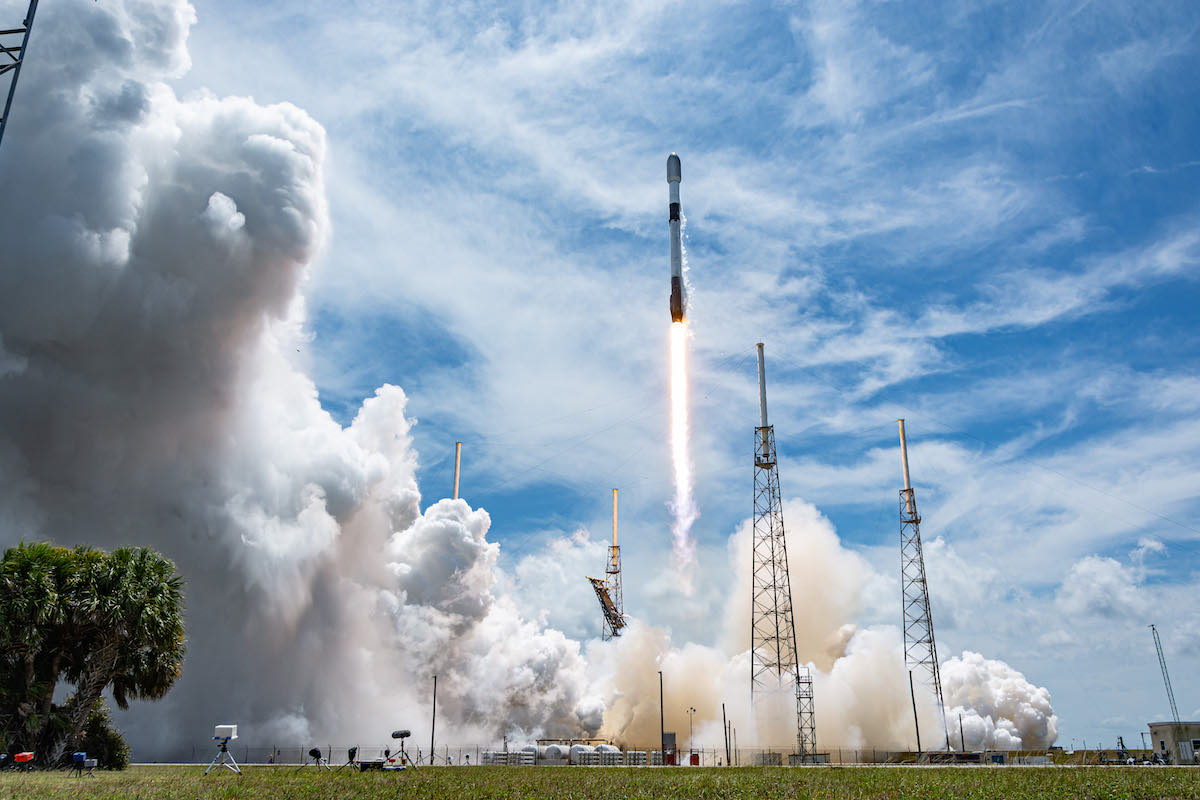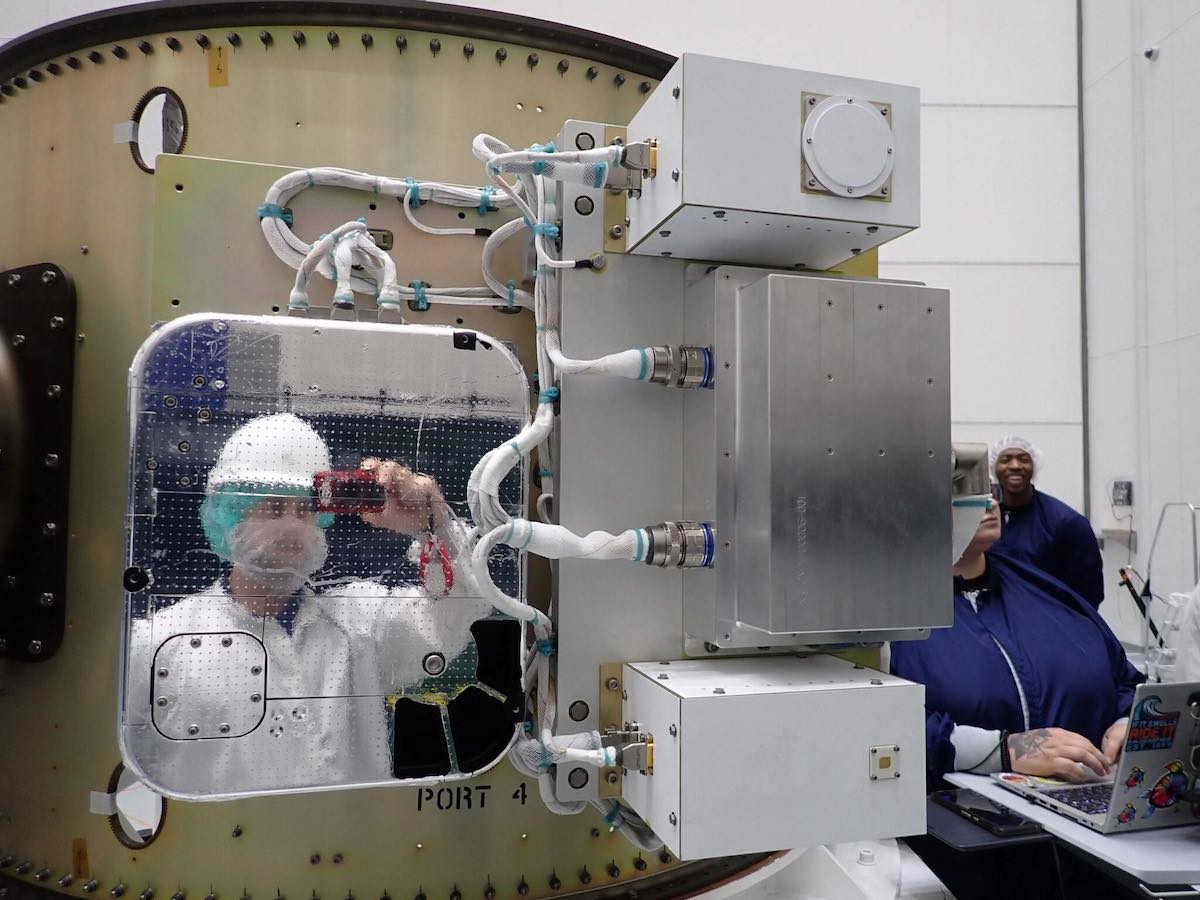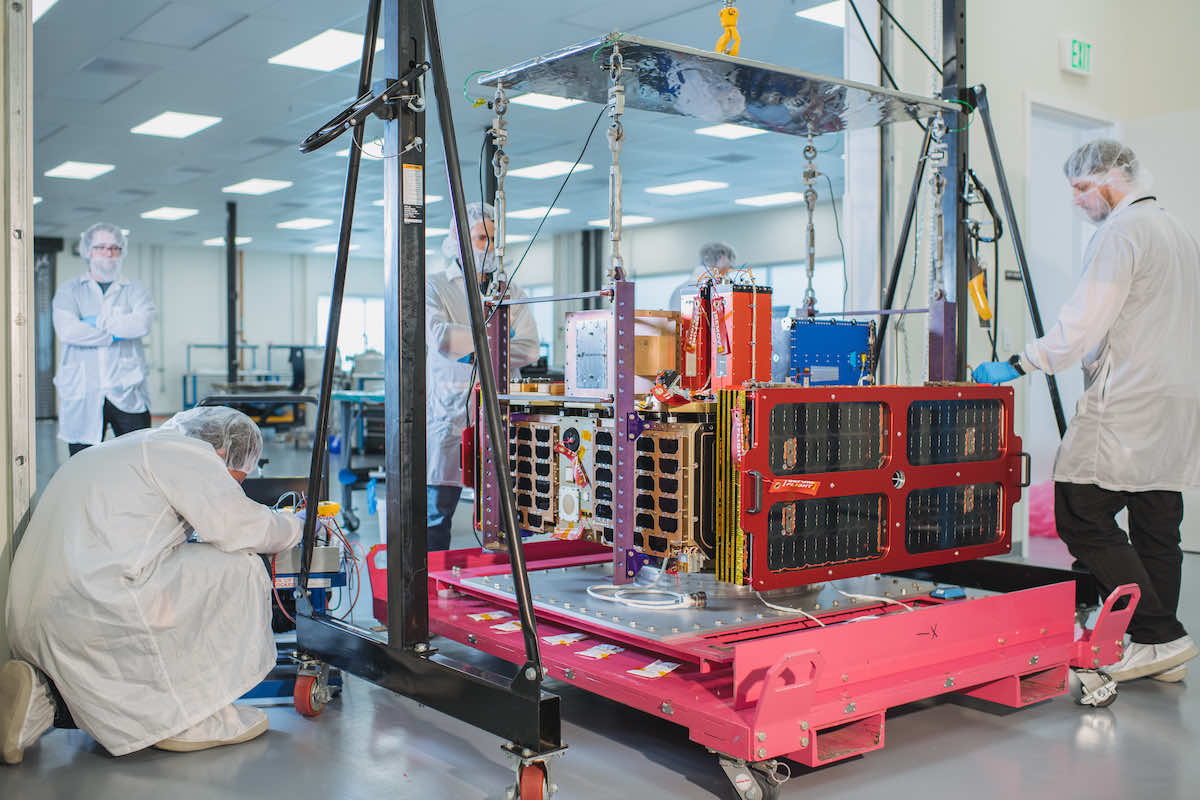
SpaceX launched a Falcon 9 rocket Wednesday packed with 59 small satellites and research experiments, including an innovative commercial water-propelled orbital transfer vehicle from Momentus and a pair of NASA tech demos testing laser communications and proximity operations.
Loaded to the brim with scientific and commercial payloads, the Falcon 9 rocket lifted off from pad 40 at Cape Canaveral at 2:35 p.m. EDT (1835 GMT) Wednesday. SpaceX called a brief hold in the countdown to complete thermal testing for the rocket’s carefully-choreographed payload deployment sequence.
The Falcon 9 rocket headed southeast from Cape Canaveral, then veered south along Florida’s east coast to place the mission’s 59 payloads into polar orbit. The first stage fired its nine Merlin engines for 2 minutes, 16 seconds, then separated from the Falcon upper stage to begin its return to Florida.
The first stage pulsed cold gas nitrogen thrusters to flip around and fly tail-first, then ignited three of the Merlin engines for a boost-back burn at the edge of space to reverse course and head back to Cape Canaveral Space Force Station.
The booster extended titanium grid fins to help steer the rocket back through the atmosphere, then fired three of its engines again for a re-entry burn. After slowing to a velocity less than the speed of sound, the rocket fired its center engine for a final braking maneuver just before a vertical touchdown on four legs at Landing Zone 1, less than 6 miles (10 kilometers) from the launch pad.
Less than nine minutes after launch, SpaceX’s Falcon 9 first stage booster returned to Landing Zone 1 at Cape Canaveral. This was the eighth flight of this reusable first stage, and SpaceX’s 122nd successful booster landing overall. https://t.co/XaRNoiX1He pic.twitter.com/QNil3b5DMn
— Spaceflight Now (@SpaceflightNow) May 25, 2022
The first stage on Wednesday’s mission — tail number B1061 — made its eighth launch and landing. It debuted in November 2020 on a NASA crew mission carrying four astronauts to space, then launched another four astronauts on a crew flight in April 2021.
SpaceX launched the booster again last June with a radio broadcasting satellite for SiriusXM, last August with a Dragon cargo capsule heading to the International Space Station, and in December with a NASA X-ray astronomy satellite. The booster has now launched three times this year: Feb. 3 with 49 Starlink internet satellites, April 1 with the Transporter 4 rideshare mission, and Wednesday on the Transporter 5 mission.
While the booster returned to Cape Canaveral after Wednesday’s liftoff, the Falcon 9’s second stage engine burned about six minutes to reach a preliminary parking orbit.
After engine cutoff, a self-contained payload from Nanoracks inside a box mounted on the upper stage was programmed to begin a 10-minute experiment to demonstrate metal cutting in orbit. The Outpost Mars Demo-1 experiment included three small coupons of corrosion resistant steel, which a robotic arm will attempt to cut using friction milling technology.
Nanoracks says the experiment is a first step in demonstrating metalworks in orbit, which could lead to advancements in space manufacturing and salvaging, including the conversion of used launch vehicle upper stages into orbiting habitats and research platforms.
The metal cutting experiment was expected to complete about 20 minutes after launch, then was supposed to downlink data and imagery to scientists through ground receiving stations.

The upper stage’s work wasn’t finished. Another engine firing occurred 55 minutes into the flight to place the satellite payloads into a near-circular orbit at an altitude of about 326 miles (525 kilometers), and an inclination of 97.5 degrees to the equator.
Then the Falcon 9 began releasing the rest of its commercial and government payloads.
The satellite passengers on the Transporter 5 mission included the first Vigoride orbital transfer vehicle built by a startup named Momentus, which will demonstrate a novel water-based propulsion system.
There was also a Sherpa transfer vehicle from Spaceflight, a company that specializes in brokering rides to space for small satellites, with its own roster of payloads. Another orbital transfer vehicle from the Italian company D-Orbit also separated from the Falcon 9 upper stage to conduct orbital maneuvers before releasing multiple commercial smallsats.
“The orbital transfer vehicle that we call Vigoride is very versatile,” said John Rood, Momentus’ chairman and CEO, in a pre-launch interview with Spaceflight Now. “It can carry small satellites, cube satellites, nanosatellites, pico satellites, all simultaneously, and it uses a water-based propellant and microwave electrothermal thruster.”
Headquartered in San Jose, California, Momentus had to wait longer than it hoped to fly the the first Vigoride orbital transfer vehicle. An earlier version of Vigoride was originally slated to launch in early 2021. The U.S. government withheld regulatory licenses for the Vigoride demo mission, citing national security concerns stemming from the company’s original ownership by two Russian citizens.
The hold-up forced the Russian owners to divest their interest in Momentus, which is now a public company. Rood took the helm of Momentus last year, and the company secured U.S. government approval for the Vigoride demo mission.

Momentus’ orbital transfer vehicle is similar in purpose to space tugs developed by other companies, like Spaceflight and D-Orbit, both of which had their CubeSat carriers on the Transporter 5 mission.
The space tugs can change their altitude, inclination, or other orbital parameters, delivering small payloads to different locations in space than the drop-off orbit of the main rocket. The transfer vehicles can reposition small satellites into orbits more favorable for their missions.
Some transfer vehicles use conventional propulsion, with thrusters powered by liquid propellants. Others are testing electric thrusters, a lower-thrust but higher-efficiency propulsion option.
Rood said the water-based propellant used on Vigoride vehicle provides performance in a “sweet spot” between chemical and electric propulsion, with higher efficiency then conventional rocket fuels, and higher thrust the ion thrusters.
“It’s H20, it’s water as a propellant,” Rood said. “The way this works is similar to the microwave you use in your home. We use microwave energy with a magnetron to heat water vapor to a temperature that’s roughly half the temperature of the surface of the sun.
“The real science comes in to control that resulting plasma, making sure it doesn’t just melt through everything inside, including the nozzle,” Rood said. “And then controlling that plasma to expel it through the rocket nozzle to therefore produce thrust.”
The first Vigoride vehicle carries several customer payloads. The flight plan called for the transfer vehicle to deploy those small satellites, then begin orbital adjustments using its two water-fueled thrusters.
The Vigoride orbital transfer vehicle had an empty weight, or dry mass, of about 270 kilograms (about 600 pounds), according to Rood.
“This microwave electrothermal thruster technology has been in development since the 1980s by university researchers, but Momentus is a real pioneer in bringing it to the marketplace and using it in space.”
Momentus demonstrated a scale version of the thruster in 2019, but the propulsion system on the Vigoride transfer vehicle has many advancements over that test unit.
“This will really be the first full-scale usage of the technology in space,” Rood said. “We expect to learn a lot.”
Momentus also booked a port on the Falcon 9 rocket to accommodate customer payloads, which deployed directly from the upper stage in orbit.
Other payloads on the Transporter 5 mission included five commercial ICEYE radar observation satellites, each nearly 200 pounds (100 kilograms) in mass. There were four small optical Earth-imaging satellites from the Argentine company Satellogic, growing its constellation to 26 operational spacecraft. The Transporter 5 mission launched three microsats from the Canadian company GHGSat, which is deploying a fleet of small satellites to monitor global greenhouse gas emissions.
There were also three formation-flying spacecraft on the Transporter 5 launch for HawkEye 360, a U.S. company building a satellite constellation to detect and locate the source of terrestrial radio signals. HawkEye 360 said earlier this year its RF monitoring satellites detected GPS interference in Ukraine as Russian military forces invaded the country.
Umbra, a startup based in Santa Barbara, California, launched its third radar remote sensing satellite on the Transporter 5 mission. Another California-based company, GeoOptics, also launched two small satellites for its commercial weather monitoring constellation.
There were five Lemur 2 CubeSats on-board from Spire Global to track weather, aviation and maritime activity from space, support data relay services, host an optical payload, and test radio frequency detection technology for the UK Ministry of Defense.
The U.S. military’s Missile Defense Agency had two small tech demo spacecraft on the Transporter 5 mission to test inter-satellite communications links.
NASA had two CubeSat missions launching on the Transporter 5 mission.
One of the CubeSats is named PTD 3, developed at NASA’s Ames Research Center to host a laser communication experiment from MIT’s Lincoln Laboratory. The Terabyte Infrared Delivery, or TBIRD, experiment will test laser data links between a small satellite and a ground station, helping prove technology that could allow satellite networks to transmit vast volumes of data much faster than through conventional radio systems.
The other NASA payload on the Transporter 5 launch was the CubeSat Proximity Operations Demonstration, which will demonstrate rendezvous, proximity operations, and docking using two shoebox-sized CubeSats.
One of the CubeSats on the Transporter 5 mission also carried the cremated remains of 47 people, part of a commercial memorial service provided by Celestis.
The launch Wednesday marked SpaceX’s 22nd mission of the year. The next Falcon 9 launch is scheduled for no earlier than June 7, when a Falcon 9 rocket is set to take off from Cape Canaveral with the commercial Nilesat 301 geostationary communications satellite for the Egyptian operator Nilesat.
Email the author.
Follow Stephen Clark on Twitter: @StephenClark1.
